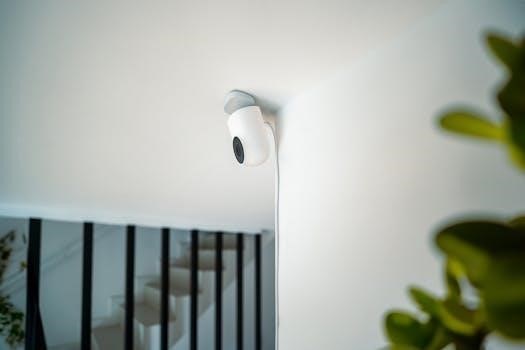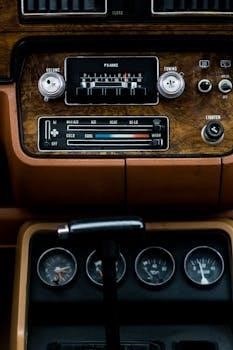Hampton Bay Ceiling Fan Remote Control⁚ A Comprehensive Guide
Welcome! This guide provides comprehensive information on Hampton Bay ceiling fan remotes. We explore remote functions, troubleshooting common issues, pairing instructions, safety precautions, and tips for optimal performance, ensuring seamless fan control.
Understanding Hampton Bay Ceiling Fan Remotes
Hampton Bay ceiling fan remotes are essential components for controlling fan operation. They use a transmitter to send signals to a receiver within the fan, providing simple instructions for speed, light, and direction. Proper functioning relies on synchronized frequency settings between the remote and receiver. Many issues arise from unsynchronized remote and receiver or dead batteries. Remotes vary, so consult the manual for model-specific instructions. Some remotes may not need pairing but work immediately with compatible fans. Understanding these basic principles is crucial for effective troubleshooting and maintaining seamless fan control. It is important to use manufacturer-supplied parts.
Common Issues with Hampton Bay Remotes
Hampton Bay remotes can experience issues like unresponsiveness, light malfunctions, and fan speed problems. Troubleshooting often involves checking batteries, power, and dip switch settings to restore functionality.
Remote Not Responding
A non-responsive Hampton Bay remote is a common frustration. This issue often stems from simple causes. Initially, verify that the remote’s batteries are fresh and correctly installed. A weak battery can hinder signal transmission. Ensure there’s a clear line of sight between the remote and the ceiling fan receiver, obstructions may interfere. Also, confirm that the fan’s power supply is active; check the circuit breaker. If the problem persists, examine the dip switch settings within the remote and receiver, making sure they match. Resetting the remote or re-pairing it with the fan may also resolve this issue.
Light Not Working
If your Hampton Bay ceiling fan light isn’t working, begin by checking the light bulb itself. Ensure it is properly screwed in and hasn’t burned out. Next, examine the light kit’s wiring connections within the fan housing for any loose or disconnected wires. If using a remote, confirm that the light control function hasn’t been accidentally disabled. Check the remote’s settings and try resetting it. If issues persist, the problem might lie within the receiver unit inside the fan. In such cases, consulting the fan’s manual or contacting customer service is advisable for further troubleshooting.
Fan Speed Problems
Experiencing inconsistent fan speeds with your Hampton Bay ceiling fan? Start by verifying that the fan blades are properly balanced and securely attached, as imbalance can affect performance. Inspect the remote control for any accidental speed setting changes. Attempt to reset the remote to its default settings. If the problem persists, examine the dip switch configuration on both the remote and receiver unit within the fan. Mismatched settings can cause speed irregularities. If using a DC fan, consult the owner’s manual for specific pairing instructions. If issues continue, consider contacting customer service for advanced troubleshooting assistance;

Troubleshooting Steps
Let’s begin! This section outlines key troubleshooting steps for Hampton Bay ceiling fan remotes. We’ll cover battery checks, power verification, and dip switch configurations to restore your remote’s functionality effectively.
Checking the Batteries
First and foremost⁚ Ensure the remote’s batteries have sufficient charge. Open the battery compartment, usually located on the back of the remote. Remove the old batteries and inspect for any corrosion or damage. If present, clean the contacts with a dry cloth. Install new batteries, matching the polarity markings (+ and -) inside the compartment.
Important consideration⁚ Low battery power is a common cause of remote malfunction. Even if the remote appears to function intermittently, replacing the batteries is a crucial first step in troubleshooting. After replacing, test the remote by pressing various buttons to see if the fan and light respond accordingly.
Power Supply Verification
Confirming power⁚ After checking batteries, verify that the ceiling fan itself is receiving power. Check the wall switch connected to the fan is in the “on” position. Inspect the circuit breaker in your electrical panel that controls the fan’s circuit. If the breaker has tripped, reset it.
Addressing further issues⁚ If the breaker trips repeatedly, it suggests a potential wiring issue or overload, requiring professional electrician assistance. Ensure all wiring connections to the fan are secure and properly insulated. Loose or faulty wiring can disrupt power flow and prevent the remote receiver from functioning correctly.
Dip Switch Configuration
Understanding dip switches⁚ Hampton Bay remotes use dip switches for frequency settings, establishing communication between the remote and receiver. Access the dip switch compartment on both the remote and the receiver unit (usually located in the fan’s canopy).
Synchronization process⁚ Ensure the dip switch settings on the remote match those on the receiver. Any mismatch prevents proper remote function. Use a small tool to adjust the switches. After changing settings, test the remote’s functionality. If issues persist, try different dip switch combinations, noting that some models don’t need pairing.

Pairing and Resetting the Remote
Regain Control⁚ This section details how to pair your Hampton Bay remote with the ceiling fan receiver. Learn to reset the remote and synchronize dip switch settings for renewed functionality.
Remote Button Reset Instructions
If your Hampton Bay ceiling fan remote control or wall fan control unit has suddenly stopped working, it might be related to frequency settings. Resetting the remote can often resolve this.
First, consult your Hampton Bay ceiling fan manual. Look for specific instructions on how to reset the remote, as processes vary. Generally, this involves removing the batteries, pressing a specific button (often the “Power” or “Fan Stop” button) for a set time (e.g., 5-10 seconds), and reinserting the batteries. This procedure clears any old signals and prepares the remote for re-pairing. Consult your manual!
Dip Switch Settings and Synchronization
Many Hampton Bay ceiling fan remotes utilize dip switches for frequency synchronization. Dip switches are small switches located in the battery compartment of the remote and inside the receiver unit of the fan. To ensure proper communication, the dip switch settings in the remote must match the settings in the receiver.
If the fan is not responding to the remote, check these settings. Ensure that the dip switches are in the same position (either “up” or “down”) on both the remote and the receiver. A mismatch is a common cause of remote malfunction. Use a small object to adjust the switches.
Pairing Process After Power Restoration
After restoring power to your Hampton Bay ceiling fan, especially after an outage, the remote may need to be re-paired. Within 20 seconds of power restoration, press and hold the power button on the remote. This initiates the pairing sequence, allowing the remote to communicate with the fan’s receiver.
Listen for a clicking sound, which indicates successful pairing. If successful, the fan will respond to the remote commands. If you don’t hear a click, repeat the process. Ensure the remote batteries are fresh and properly installed. This simple step often resolves control issues.
Advanced Troubleshooting
If basic troubleshooting fails, further investigation may be needed. Identifying your remote model and consulting customer service can provide specific solutions for persistent issues with your Hampton Bay ceiling fan remote.
Identifying the Remote Model
Accurately identifying your Hampton Bay remote model is crucial for effective troubleshooting and finding compatible replacement parts. The model number is typically found on the back of the remote, inside the battery compartment, or in the original documentation.
Once you have located the model number, compare it with online resources, such as the Home Depot website, to find specific troubleshooting guides or replacement options for your Hampton Bay ceiling fan remote. This precise identification will streamline the process of resolving any issues and ensure compatibility when seeking replacement parts. Using the correct information is key.
Contacting Customer Service
If troubleshooting steps fail, contacting Hampton Bay customer service is recommended for expert assistance. You can find their contact information in your product manual or on the Home Depot website. Provide the fan and remote model numbers, along with a detailed description of the issue you’re experiencing, and information about any troubleshooting steps you have already attempted.
Customer service can offer specific guidance, warranty information, and potential solutions tailored to your remote and fan model. They may also be able to direct you to authorized repair services or replacement parts, ensuring a resolution to your remote control problems.

Additional Tips and Considerations
Explore universal remote compatibility for Hampton Bay ceiling fans. Consider replacement remote options if the original is lost or damaged. Regular maintenance ensures longevity and optimal performance for continued convenience.
Using Universal Remotes
Integrating universal remotes with Hampton Bay ceiling fans offers a flexible control solution. Some universal remotes can be programmed to operate ceiling fan functions, potentially simplifying your home entertainment or control setup. Refer to the universal remote’s manual for specific programming instructions. You may need to identify the correct code for Hampton Bay fans.
Replacement Remote Options
Lost or damaged your Hampton Bay remote? Don’t worry, replacement options are available. You can find original replacement remotes online through retailers like Home Depot, or specialized remote replacement websites. Ensure the replacement remote is compatible with your specific Hampton Bay ceiling fan model.
Consider universal ceiling fan remotes as an alternative. These remotes often work with various fan brands, including Hampton Bay. When purchasing, check the remote’s compatibility list and programming instructions. Some universal remotes offer added features, like timers or dimming control. Always verify that the replacement uses the correct frequency to work with your receiver.
Safety Precautions
Safety first! When working with ceiling fans and remotes, always disconnect power before any installation or repairs. Use only manufacturer-approved parts to avoid fire hazards and potential injuries.
Avoiding Fire and Injury Risks
To mitigate fire and injury risks associated with Hampton Bay ceiling fan remote controls, always ensure the power is disconnected during installation or maintenance. Verify that all wiring connections are secure and conform to local electrical codes. Never modify the remote or fan components, as this can compromise their safety features. Regularly inspect the fan and remote for signs of damage, such as frayed wires or cracked casings. Replace any damaged parts immediately. Keep the remote away from water and extreme temperatures to prevent malfunction and potential hazards. By adhering to these precautions, you can ensure safe and reliable operation.
Using Manufacturer-Supplied Parts
Always utilize manufacturer-supplied parts when repairing or replacing components of your Hampton Bay ceiling fan and its remote control. Using non-original parts can lead to compatibility issues, reduced performance, and potential safety hazards. Manufacturer-supplied parts are specifically designed and tested to work seamlessly with your fan, ensuring optimal functionality and longevity. Substituting with generic or third-party parts may void your warranty and increase the risk of electrical issues, fire, or personal injury. Consult your fan’s manual or the Hampton Bay customer service for guidance on obtaining the correct replacement parts. Prioritizing genuine components guarantees safe and reliable operation.

Installation and Wiring Guidelines
Crucially, follow all manufacturer’s installation and wiring guidelines when setting up your Hampton Bay ceiling fan. Correct wiring ensures safe and efficient operation. Ignoring these guidelines can cause damage and safety risks.
Proper Installation Techniques
Proper installation techniques are critical for the safe and effective operation of your Hampton Bay ceiling fan. Begin by ensuring the electrical supply is turned off at the breaker. Carefully follow the manufacturer’s instructions for mounting the fan bracket to a securely anchored ceiling junction box. Use only the provided hardware to avoid compromising the fan’s stability. When wiring the receiver, double-check all connections for tightness and proper insulation. Securely tuck all wires into the mounting bracket, avoiding any pinching. Lastly, balance the fan blades to prevent wobbling, and test all functions before completing the installation.